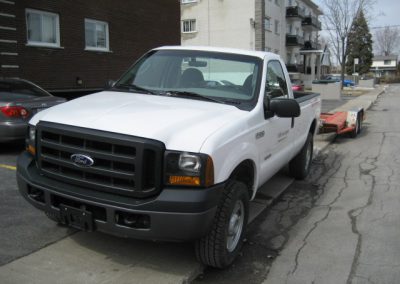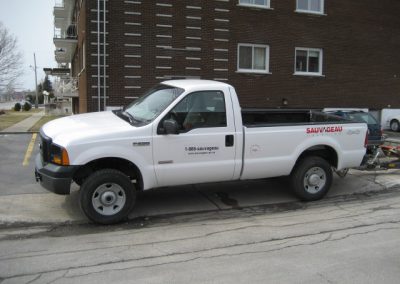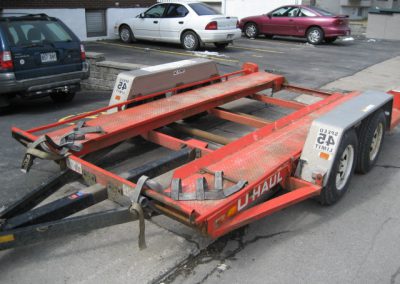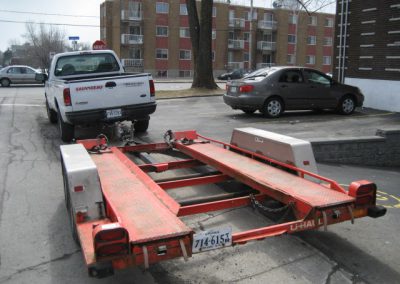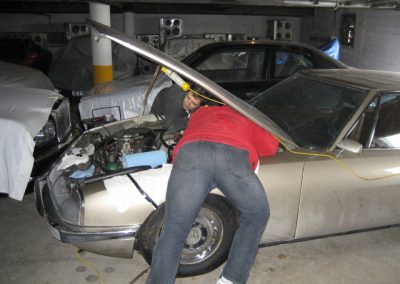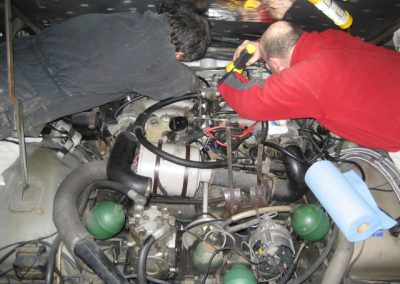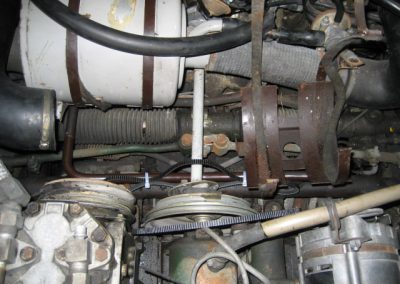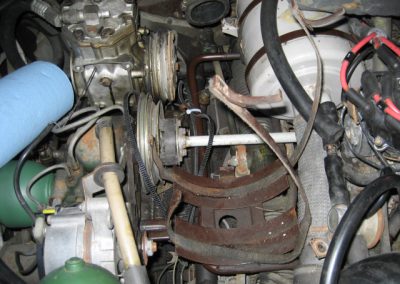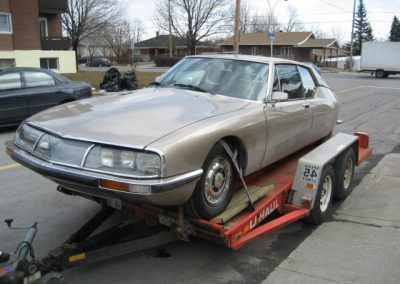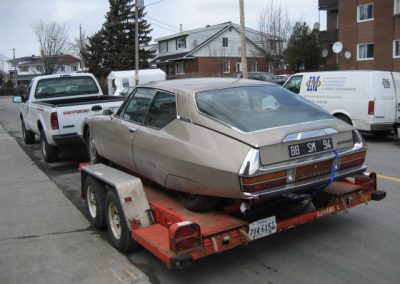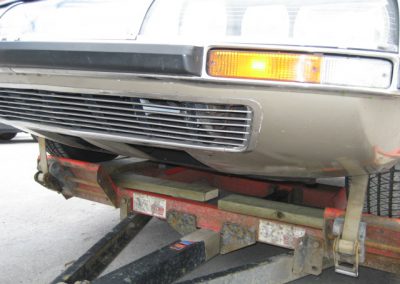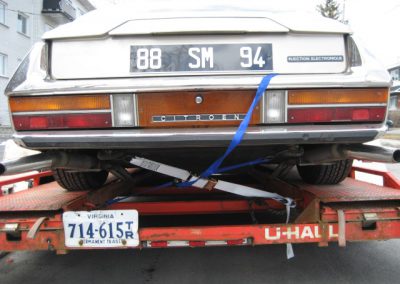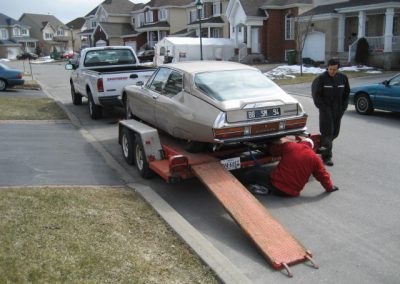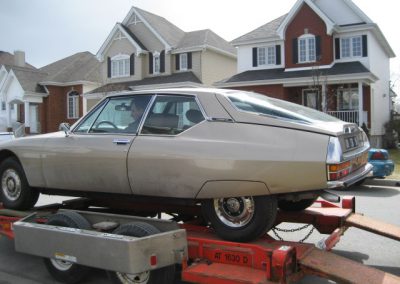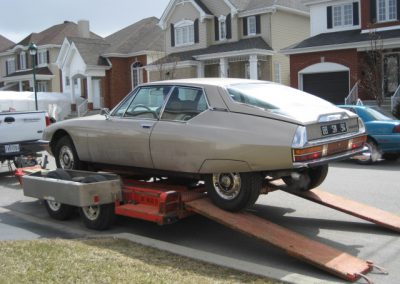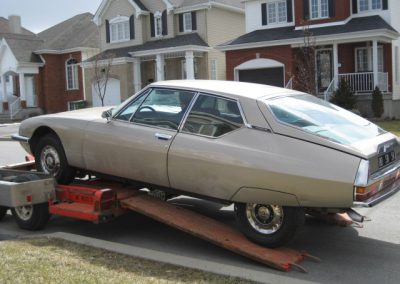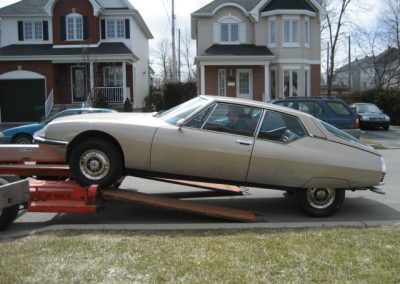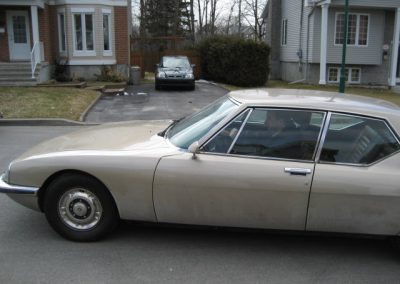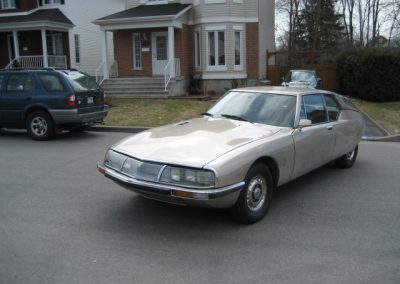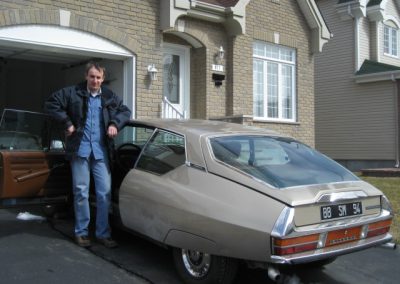Last part of the trip (April 2007)
After a few sunny days by the end of March, the community of antique car enthusiasts in Québec is in turmoil 😉 Everybody plans to get his car out of its winter parking space. Of course, I’m no exception, even if we all know that April is usually still cold.
So I plan to go get the SM out as soon as possible. Friday April 6 is a holiday, it’s Easter day, so it’s great, with two more days off after. I also plan to take the entire following week off to work on the car.
As planned, unfortunately, days are still gray and cold during this beginning of March. Too bad, it’s planned, I confirm the operation with two friends who are going to help me and are very handy mechanical guys.
I forgot so-called professional towing guys, I rent a trailer and a pick-up truck to pull it. I love driving this kind of truck, so I don’t chose the smallest one 😉
I get the truck, the trailer and my two colleagues, and we arrive at the garage around 10:30 or 11 AM. I tell to the building manager that we’ll have a “little preparation work” to do before being able to get the car out. At this time, I don’t know if the preparation work will last one or ten hours!
I bring a tool box, many general purpose material (straps, towing cable), parts (hoses, clamps, thermostat) and some “war field repair” equipment (duct tape, steel wire, tubing pieces, tyraps). With all this equipment, we are ready!
A few days before, I went to see the SM to confirm a big doubt: is it possible that the suspension didn’t go up the last time simply because the height lever was in its lowest position? And yes, shame on me, the height lever was in low position. You know, I’m used to non working SMs, so I don’t think that if the car doesn’t go up it may be that she’s asked not to 😉 French transporter probably used the engine to load the car and then he had to put the car in its lower position to secure it inside the container. But it’s ok, I like simple solutions like that, even if I look quite dumb 😉 So here is the biggest problem solved, suspension should go up this time.
We begin by charging the battery, with a quick and powerful charger. Fortunately, there is electricity available inside the garage. I discover that there is a power cut-off device under the hood but it seems to not cut many things.
Then we add water into the coolant tank to track the leak. Fortunately, it’s a big leak. As soon as we begin filling the tank, we hear water dropping on the ground. We quickly discover that the cooling duct at the exit of the water pump is badly damaged. Of course, access to the duct is the main problem, it’s a SM, don’t forget that 😉
Philippe and Jacques work to find a solution to reduce the leak and while they are doing that, I install a new alternator belt. I take the opportunity to have a second belt ready in case of a new breakage, by passing it around the secondary shaft and securing it. It’s not too difficult, I thought it would be worse. The alternator has a little alignment defect, it probably explains why the previous belt broke. For the moment, I forget about that, I’ll work on that later, I just hope that the new belt will last enough to load and then unload the car.
smie_135
Philippe on the left and Jacques on the right work on a temporary solution near the water pump
Jacques finds a little plastic piece in his car, a kind of a plastic label, Philippe and him will use it to reduce the leak. They put the plastic piece around the leaking duct and use clamps to secure it in that position.
We fill again the water tank and this time we don’t see any leak. We are supposed to be ready to drive the car out. It’s around 1 or 2 PM if I remember well.
We pack everything and we prepare the trailer, this way we are ready to load the car if the engine starts and everything works.
I turn the key, the engine starts easily and runs fine. Last time, the engine stalled but now that the battery is in good shape and the alternator gives energy, everything is fine. We don’t see any coolant leak, that’s great, we just hoped to reduce the leak, not to stop it.
Then it’s the moment of truth for the suspension. The front side goes up first, which is not really normal, and then we here a “clong” indicating that the rear side started to lift also. It’s confirmed, tires were touching inside the rear wheel arches because suspension buffers were simply missing. As soon the suspension lifts, the car moves a little bit, meaning that there is no problem with the rear brakes.
So everything is ok, we just have to load the car. I wait for the engine to heat-up and I drive the car out to the trailer. I select the upper position of the suspension to securely climb onto the trailer and it goes well.
smie_139
The left fender tips down to make space for the door when it opens, what an interesting feature
We are about ten kilometers from my home, I drive slowly, the trailer does a very good job, the SM doesn’t move at all and the pick-up truck pulls with no effort.
smie_143
You see here the left fender of the trailer tipped down. With a SM in its lower position, it’s very practical
Everything ends around 2:30 PM, it’s been faster than expected.
Epilogue (April 2007)
When the car arrived in January, everything went bad. This time, it’s the opposite. A little preparation and, even more, enough time to do things the good way on site, make the difference. When we want or have to go fast, we do plenty of mistakes.
Thank you Philippe and thank you Jacques. You also made the difference.
Suspension had no problems, rear brakes were not jammed and the engine only needed electrical power to work fine. The coolant leak and alternator belt problems were not linked. It shows one again that everything can happen on an antique car, which probably was not used a lot these past years and was not used at all for several months.
Next step will be to prepare the car for the technical inspection required to have the right to drive it on Québec roads. This inspection is not very demanding but I still have to make sure that everything works well, security devices for example. Unfortunately, weather is not on my side and I depend on weather because the car is currently outside (my other SM is in my home’s garage).
